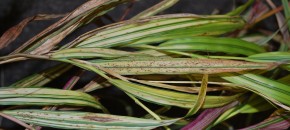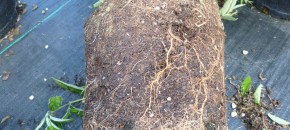Potato Disease Forecasting Report 8-6-13 – Click to Download We will be tracking DSVs for Late blight development and calculating P-days for initiating the first early blight fungicide application. The first late blight fungicide application is recommended once 18 DSVs accumulate from green row. Green row typically occurs around the first week in May in southern […]
Continue reading...Tomato Disease Forecasting Report 8-6-13
8-6-13 Tomato Report – Click to Download Disease severity values (DSVs) for early blight, septoria leaf spot, and tomato anthracnose development are determined daily based on leaf wetness (due to rainfall, dew) and air temperature. On a daily basis DSV values can range from 0 to 4 where 0 = no chance for disease development […]
Continue reading...Touch of Gray

Everybody keeps asking me “any gray leaf spot yet?” And I answer, “why yes, but not where you think.” Gray leaf spot was diagnosed last week on samples of Hakonechloa that were submitted from a central New Jersey nursery grower.
Continue reading...Befenthrin Labeled for Tree Fruit
We received notice on Friday 8/2, that 3 formulations of bifenthrin are now labeled for use in NJ peaches, nectarines and apples for control of brown marmorated stink bug (BMSB). This is the best product we have for BMSB, and although it is late in the season, growers should find it very useful. There is […]
Continue reading...Battling Green and False Kyllinga in New Jersey Turfs
By Jim Murphy We are seeing and hearing about increasing problems with green and false kyllinga; both are very troublesome invasive weed species that have moved northward into New Jersey. Green kyllinga and false green kyllinga are very similar in appearance, and both are referred to as green kyllinga. Green kyllinga is very difficult to […]
Continue reading...Oriental Beetle Treatment Window Closes for NJ Nurseries

In most areas of NJ, the application timing of imidacloprid to nursery containers to achieve best efficacy against Oriental beetle grubs (Anomala orientalis) has now expired. The majority of eggs are laid during late June through early July and by the time August arrives, many of the grubs will have begun to molt into the 2nd instar stage. If imidacloprid […]
Continue reading...